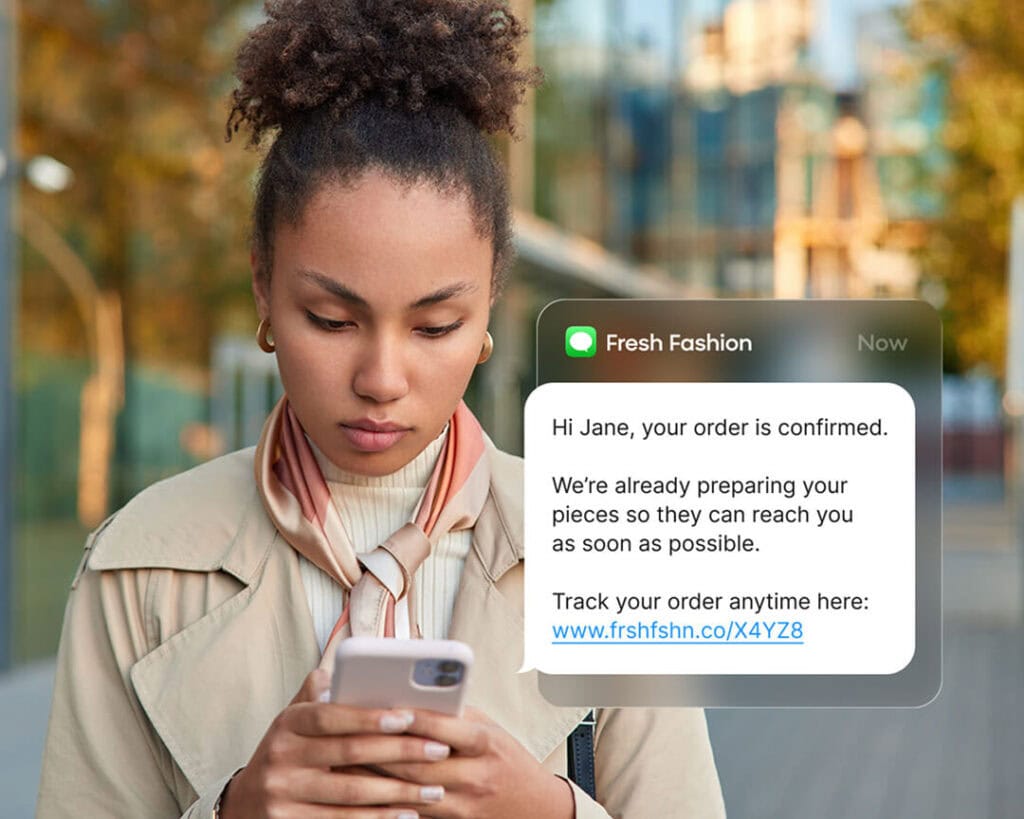Transactional messaging has evolved from a backend necessity to a strategic customer experience driver. Speed, personalization, and reliability aren’t differentiators — they’re baseline expectations.
And yet, customers remain frustrated by slow confirmations, generic updates, and delivery uncertainty. Legacy systems can’t meet modern demands, resulting in missed moments and lost trust. This creates a clear opportunity for brands that can deliver exceptional transactional experiences.
Modern transactional messaging platforms deliver:
- Real-time, AI-driven personalization
- Autonomous, always-on delivery
- Secure, link-level click assurance
- Unified performance reporting
- Speed without the need for plug-ins

Read on to learn how you can take your transactional messaging strategy to the next level and find new ways to engage your customers.
Why Transactional Messaging Matters in 2025
Transactional messages — confirmations, updates, resets — are trust touchpoints that deepen brand relationships when executed correctly. Unlike promotional campaigns, these messages are triggered by specific user actions and carry exceptional importance in the customer journey.
The stakes are high. Transactional messages achieve 80%+ open rates, but carry equal risk when delays or failures occur. This makes reliability and personalization critical for maintaining customer trust and satisfaction.
Modern transactional messaging requires:
- Instantaneous dispatch upon trigger events
- Deeper content personalization beyond basic information (e.g., first name)
- Airtight security and delivery guarantees
- Seamless cross-channel experiences
Unlike legacy platforms focused purely on throughput, modern platforms synchronize message timing, content, and intent with the complete customer journey. This transforms routine notifications into meaningful engagement opportunities that drive retention and revenue.
For more insights, check out our comprehensive guide to transactional SMS best practices.
Achieving True Personalization at Scale
The era of “Dear [First Name]” personalization is over.
Today’s consumers expect dynamic content tailored to their specific context, preferences, and behaviors — all delivered in real time based on their unique customer profile.
Advanced transactional messaging platforms deliver true personalization through:
- Real-time updates to customer profiles
- SKU-level customization, including specific items, arrival ETAs, and warehouse logistics
- Smart usage of loyalty tier and geo-location data
- AI-driven messaging that adapts the tone and language to the situation
For example, instead of a generic “Your order has been placed” message, sophisticated systems can send a message like, “Your Vans Old Skool Shoes are being prepared at our Austin warehouse and will arrive tomorrow by 2 p.m. Your VIP status ensures priority handling.”
This message incorporates specific product details, location-aware fulfillment information, delivery timing, and loyalty recognition — all generated automatically from integrated customer and inventory data.
Real-Time Delivery Architecture for Peak Performance
Personalized transactional messages mean nothing if they’re delayed, throttled, or lost during high-traffic periods. Reliability must be engineered into the dispatch process from the ground up, especially during critical shopping seasons (i.e., back-to-school, Black Friday, etc.).
Advanced platforms solve delivery challenges through:
- Dedicated delivery lanes that separate transactional from promotional streams
- AI-powered queuing systems that bypass traditional ESP throttling
- Enterprise-grade uptime standards, even during peak season traffic spikes
- SMS delivery in milliseconds via intelligent queuing algorithms
The Fast Lane Advantage
Traditional email service providers treat all messages equally, creating bottlenecks when promotional campaigns consume available bandwidth. Modern transactional messaging platforms maintain dedicated infrastructure specifically for time-sensitive communications.
During peak shopping seasons, this architectural difference becomes critical. While legacy systems struggle with queue backlogs, dedicated transactional lanes ensure order confirmations arrive instantly. Speed directly correlates with trust — customers expect and rely on timely delivery for peace of mind.
Autonomous Failover for Always-On Reliability
Delivery reliability shouldn’t depend on manual monitoring or reactive switching between providers. Enterprise-grade platforms ensure guaranteed message delivery through intelligent automation that works behind the scenes.
Here are some key failover capabilities in modern platforms:
- Smart rerouting across multiple ESPs and SMS providers
- Channel-agnostic fallback mechanisms (email to SMS)
- Zero-code setup with automatic configuration
- Delivery confirmation tracking with every reroute attempt
For example, if a primary email provider experiences downtime during a major sales event, advanced platforms will automatically detect delivery failures and reroute messages through backup channels within seconds. Customers continue receiving confirmations without interruption, while marketing teams remain unaware of backend infrastructure issues. This autonomous approach eliminates the chaos of manually switching providers during critical moments.
Unified Analytics for Complete Visibility Across Channels
For omnichannel messaging to be effective, you need granular visibility into the performance metrics that inform your strategies. Fragmented reporting across multiple tools creates blind spots and limits improvement opportunities.
Solutions with comprehensive analytics should have:
- Real-time message status tracking: Sent → Delivered → Clicked → Converted
- Journey-level attribution across email, SMS, and push notifications
- CDP-grade segmentation by regions, SKUs, and customer personas
- Full REST API access for custom dashboards and developer tooling
Modern platforms provide unified dashboards that track transactional message performance alongside broader customer journey metrics. This integration enables marketers to understand how order confirmations influence repeat purchases or how shipping notifications affect satisfaction scores.
Data-driven personalization strategies consistently demonstrate significant revenue impact, validating the importance of having an analytics infrastructure that connects transactional touchpoints with broader business outcomes and customer lifetime value.
Security and Trust in Every Interaction
Customers expect secure, professional communications that reflect brand integrity. Broken links, suspicious domains, or unbranded messaging can instantly destroy trust and damage brand reputation.
These are some of the core security capabilities you should prioritize:
- Per-user secure links with custom short URLs
- Time-expiring URLs for sensitive actions
- Anti-spoof headers and bounce control mechanisms
- Brand-verified domain handling and authentication
Instead of directing customers to generic tracking pages, advanced systems generate unique, secure URLs that automatically authenticate users and display their specific order information. These links include time-based expiration for password resets and branded domain consistency that reinforces trust signals.
| Feature | Advanced Platform | Legacy Approach |
|---|---|---|
| Secure Links With TTL | ✅ Built-in | ❌ Manual implementation |
| Autonomous Provider Failover | ✅ Included | ❌ Third-party required |
| Unified Tracking | ✅ Native | ❌ Manual data merging |
| AI Brand Personalization | ✅ Real-time | ❌ Template-based only |
More than ever, customers demand coordinated, secure, context-rich service interactions across all touchpoints, making security and consistency non-negotiable requirements for brand trust.
Proof in Practice: ASKO – NÁBYTEK’s 200% Revenue Growth
Leading Czech and Slovak furniture retailer ASKO – NÁBYTEK faced disjointed CRM systems, low loyalty program conversion, and poor transactional automation that frustrated customers during lengthy furniture delivery processes. The company’s generic messaging approach was losing customers during critical moments.
To address these challenges, the brand turned to Bloomreach Engagement to:
- Unify CRM and behavioral data
- Offer 1:1 personalization across email and SMS
- Optimize delivery with journey attribution tracking
Thanks to the implementation of Bloomreach Engagement, ASKO – NÁBYTEK was able to drive impressive results:
- €5.5M in revenue — higher than the projected target
- 3x increase in new contacts collected
- 50% fewer email sends
- 200% increase in revenue from more targeted newsletters
The transformation demonstrated how sophisticated transactional messaging builds customer confidence throughout complex purchase and delivery processes, turning potential friction points into trust-building moments.

Make Bloomreach Your Strategic Advantage
Bloomreach combines personalization, reliability, security, and attribution at enterprise scale, resulting in superior customer experiences while also eliminating the need for patchwork integrations across multiple vendors.
Key differentiators:
- Real-time 1:1 personalization powered by Loomi AI
- Intelligent dispatch prioritization with dedicated delivery lanes
- Built-in channel failovers with zero-code setup
- Unified, journey-mapped analytics across all touchpoints
- Secure link handling personalized per user, per message
- No-code deployment with future-proof API foundation
Measurable outcomes:
- Higher conversion rates through contextual personalization
- Lower support burden via proactive, accurate communications
- Greater brand trust through reliable, secure messaging
- Reduced martech complexity by consolidating multiple tools
If you want to drive success among modern consumers, you need to move beyond legacy systems and embrace comprehensive solutions like Bloomreach for AI-powered personalization. Begin your transformation today by learning more about Bloomreach Engagement, our marketing automation technology that personalizes every customer moment.













